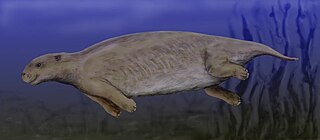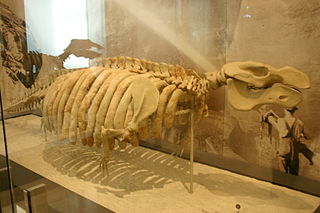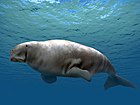
The Sirenia, commonly referred to as sea-cows or sirenians, are an order of fully aquatic, herbivorous mammals that inhabit swamps, rivers, estuaries, marine wetlands, and coastal marine waters. The Sirenia currently comprise two distinct families: Dugongidae and Trichechidae with a total of four species. The Protosirenidae and Prorastomidae families are extinct. Sirenians are classified in the clade Paenungulata, alongside the elephants and the hyraxes, and evolved in the Eocene 50 million years ago (mya). The Dugongidae diverged from the Trichechidae in the late Eocene or early Oligocene.

Steller's sea cow is an extinct sirenian described by Georg Wilhelm Steller in 1741. At that time, it was found only around the Commander Islands in the Bering Sea between Alaska and Russia; its range extended across the North Pacific during the Pleistocene epoch, and likely contracted to such an extreme degree due to the glacial cycle. It is possible indigenous populations interacted with the animal before Europeans. Steller first encountered it on Vitus Bering's Great Northern Expedition when the crew became shipwrecked on Bering Island. Much of what is known about its behavior comes from Steller's observations on the island, documented in his posthumous publication On the Beasts of the Sea. Within 27 years of its discovery by Europeans, the slow-moving and easily-caught mammal was hunted into extinction for its meat, fat, and hide.

Trichechidae is a family of sirenians that includes all living manatees and several extinct genera.

The Desmostylia are an extinct order of aquatic mammals that existed from the early Oligocene (Rupelian) to the late Miocene (Tortonian).

A flipper is a broad, flattened limb adapted for aquatic locomotion. It refers to the fully webbed, swimming appendages of aquatic vertebrates that are not fish.

Hydrodamalinae is a recently extinct subfamily of the sirenian family Dugongidae. The Steller's sea cow was hunted to extinction by 1768, while the genus Dusisiren is known from fossils dating from the middle Miocene to early Pliocene.

Halitherium is an extinct dugongid sea cow that arose in the late Eocene, then became extinct during the early Oligocene. Its fossils are common in European shales. Inside its flippers were finger bones that did not stick out. Halitherium also had the remnants of back legs, which did not show externally. However, it did have a basic femur, joined to a reduced pelvis. Halitherium also had elongated ribs, presumably to increase lung capacity to provide fine control of buoyancy. A 2014 review presented the opinion that the genus is dubious.

Prorastomus sirenoides is an extinct species of primitive sirenian that lived during the Eocene Epoch 40 million years ago in Jamaica.

Rytiodus is an extinct genus of sirenian, whose fossils have been discovered in France, Europe and Libya.

Sirenia is the order of placental mammals which comprises modern "sea cows" and their extinct relatives. They are the only extant herbivorous marine mammals and the only group of herbivorous mammals to have become completely aquatic. Sirenians are thought to have a 50-million-year-old fossil record. They attained modest diversity during the Oligocene and Miocene, but have since declined as a result of climatic cooling, oceanographic changes, and human interference. Two genera and four species are extant: Trichechus, which includes the three species of manatee that live along the Atlantic coasts and in rivers and coastlines of the Americas and western Africa, and Dugong, which is found in the Indian and Pacific oceans.

Metaxytherium is an extinct genus of dugong that lived from the Oligocene until the end of the Pliocene. Fossil remains have been found in Africa, Europe, North America and South America. Generally marine seagrass specialists, they inhabited the warm and shallow waters of the Paratethys, Mediterranean, Caribbean Sea and Pacific coastline. American species of Metaxytherium are considered to be ancestral to the North Pacific family Hydrodamalinae, which includes the giant Steller's Sea Cow.
Protosiren is an extinct early genus of the order Sirenia. Protosiren existed throughout the Lutetian to Priabonian stages of the Middle Eocene. Fossils have been found in the far-flung locations like the United States, Africa (Egypt), Europe and Asia.
Nanosiren garciae is an extinct sirenian dugong that lived in warm shallow seas in what is now Venezuela, approximately 11.610—3.6 Ma during the Miocene and Pliocene. The species is listed in the Paleobiology Database, funded by the Australian Research Council.

Prorastomidae is a family of extinct sirenians from Jamaica, related to the extant manatees and dugong. The family includes the oldest known fossils of Sirenians, represented in two genera:
Protosirenidae is an extinct primitive family of the order Sirenia.

Dusisiren is an extinct genus of dugong related to the Steller's sea cow that lived in the North Pacific during the Neogene.
Pachyosteosclerosis is a combination of thickening (pachyostosis) and densification (osteosclerosis) of bones. It makes bones more heavy, but also more fragile. The condition often occurs in aquatic vertebrates, especially those living in shallow waters, creating ballast as an adaptation for maintaining neutral buoyancy and horizontal trim. It is in no way pathological. To resist bend, it frequently is found especially in ventral bones, whereas concentration near the lungs helps in maintaining trim. Examples of animals showing pachyosteosclerosis are seacows, the extinct Plesiosauria and Mesosauria and extinct aquatic sloths.
Anomotherium is an extinct genus of manatee that lived in the shallow seas of what is now northern Germany. Its closest relative is Miosiren. Fossils of the genus have been found in the Bohlen and Doberg Formations of Germany.
Potamosiren is an extinct genus of manatee from the Middle Miocene (Laventan) Honda Group of Colombia.

Kaupitherium is an extinct dugongid sea cow that lived during the Oligocene. Fossils of the genus have been found in the Alzey Formation of Germany. Inside its flippers were finger bones that did not stick out. Kaupitherium also had the residues of back legs, which did not show externally. However, it did have a basic femur, joined to a reduced pelvis. Kaupitherium also had elongated ribs, presumably to increase lung capacity to provide fine control of buoyancy.














